BVV
-
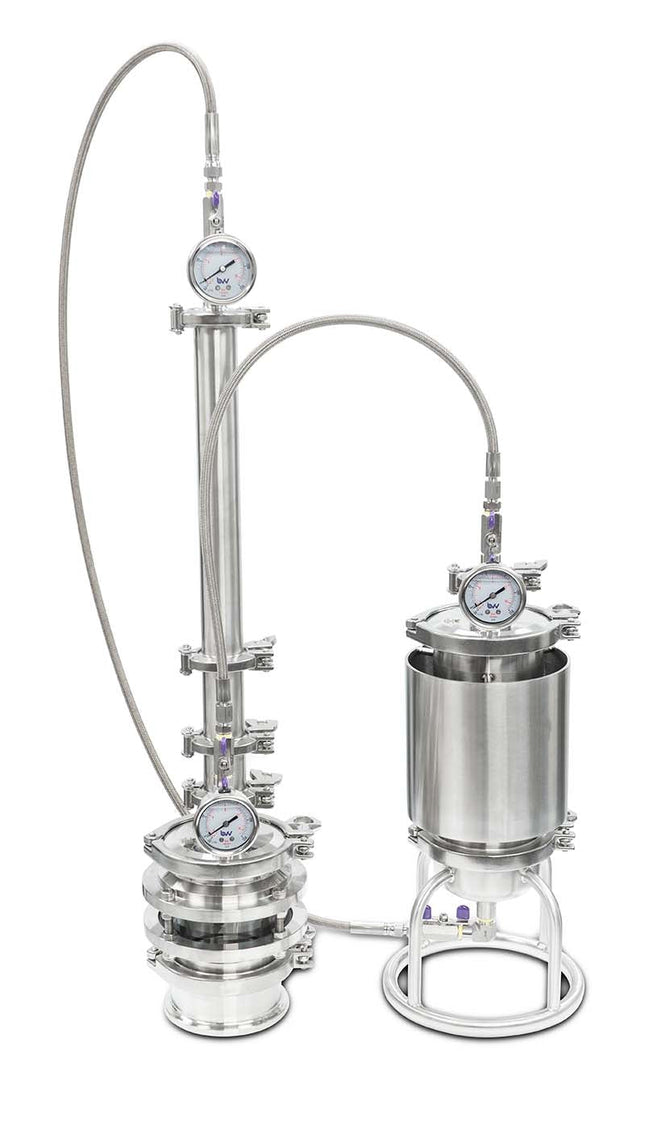

EVO Mini Closed Loop Extractor
EVO Mini Closed Loop Extractor (System comes with 1 yr. limited warranty) The EVO Mini 90 gram closed-loop extractor was designed to provide the same versatility & capability of our EVO Extractor line, allowing both the use of adsorbent filtration and pre-chilling of solvent utilizing the inline Color remediation column and the Sleeved EVO recovery tank. The EVO Mini is the perfect small batch R&D system or top-of-the-line mini extractor. Perform small batch testing of new biomass or R&D new adsorbent filtration recipes without utilizing large volumes of biomass. The Evo Mini allows you to test with hot or cold solvent, try out different ratios of powders or granular medias, and test extract new biomass before running a larger extraction. The EVO Mini comes complete with a top fill injection manifold including a compound gauge, a stainless steel butterfly valve with a 1/4" MJIC connection that injects solvent directly into the 1.5"x 12" 90-gram material column which is enclosed by 2x 100 micron Buna-N mesh gaskets. Just below the 90-gram material column is the inline 1.5" x 3" color remediation column just below the material column with a 30-gram media capacity and a filter stack utilizing both a 5 micron & 1 micron sintered disk. Below the filter stack the EVO Mini drains into the collection base equipped with a compound gauge, a 4" Short sight glass, and a stainless steel butterfly valve with a 1/4" MJIC connector. The Collection base can accommodate up to 1.1lbs of butane perfect for a 5:1 solvent to biomass ratio. Which can be evaporated with ease when used in conjunction with the Mini Evo sleeved recovery tank filled with dry ice and a hot water bath. ***Note: Solvent not included with systems unless ordered separately. Any order with butane WILL NOT SHIP EXPEDITED.*** ***DISCLAIMER: This unit is intended for LEGAL purposes only, to be used in accordance with local laws and ordinances. Use only in extremely well-ventilated areas. Check with your local fire marshal for guidance when operating indoors. KEY BENEFITS Meets or exceeds all industry listed standards Versatile in running butane, propane, and other blended solvents Perfect for R&D of media combinations or testing fresh biomass Inline color remediation Pre-chilling of solvent Extractor Configuration: Explorer: Our standard, most economical setup, perfect for the entry-level extractor on a budget. This option comes equipped with single pin clamps rated to a service pressure of 300PSI for the 4" clamp and 500PSI for the 1.5" clamp at 70F. Elite: The Elite series is the premium version of the EVO Mini that comes equipped with High-pressure clamps rated to a service pressure of 800PSI for the 4" clamp and 1500PSI for the 1.5" clamp at 70F. *All configurations are pressure tested for 24 hours before shipment using nitrogen at 100PSI. Although many of the components of the EVO Mini are rated to withstand well above 100PSI during extraction we do not recommend pressurizing any system past 100PSI. During normal operation of the EVO Mini pressures typically don't exceed 50PSI* Explorer Elite Single Pin Clamps High-Pressure Clamps Unit Includes: Injection manifold complete with a compound gauge, 1/4" butterfly valve, and a 1/4" MJIC Connection. 1.5"x12" 90 gram material column. 1.5"x6" adsorbent filtration column with 30g gram media capacity. Adsorbent filtration filter stack including 5 micron and 1 micron sintered disks. 4" collection base with splatter platter & short sight glass complete with a compound gauge, and a 1/4" butterfly valve with a 1/4" MJIC Connection. 4"x8" Sleeved EVO Recovery tank with compound gauge, polycarbonate sight glass, and a 1/4" butterfly valve, and a 1/4" MJIC Connection. (1) 1/4" 48" FJIC Stainless Steel Injection hose (1) 1/4" 24" FJIC Stainless Steel Recovery Hose Specifications: 1.5"x 12" 304 Stainless Steel Material Column- 90 gram capacity 316 Stainless Steel Fully Encapsulated Miniature Ball Valves System Rated to 150PSI Multiple 37-degree FJIC port connections 304 Stainless collection base Tri-Clamps at all interfaces make for a high pressure/standard pressure, easy-clean unit BUNA-N Gaskets are designed for Oil Processing Temp range -40-200F, and have superior solvent resistance Construction: All components are made of 304 Stainless Steel. Max Vacuum -29.9inHg High Polish Interior *Note: Column capacity may vary depending on the density of packed material and packing density. Capacity is calculated using the industry standard of 4.2g/in3. This is the upper limit for column capacity. Low density, uncut, and/or lightly packed material can reduce capacity by 50%. For best results, we recommend to tightly pack coarse ground material.
$1,120.39 - $1,204.42
-
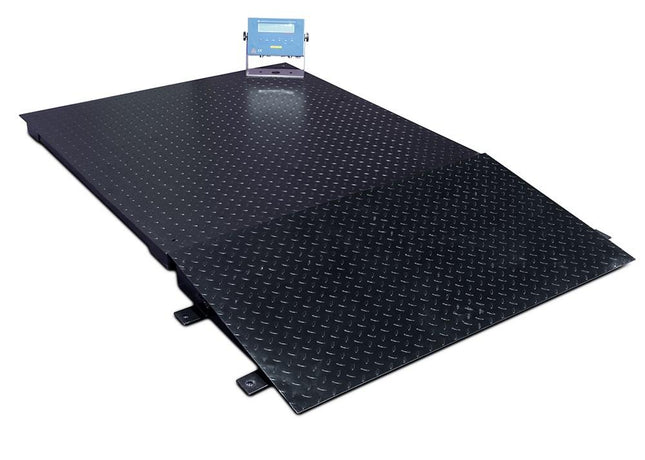

Explosion Proof Platform Scales - 3000KG
These Explosion proof platform scales come with a ramp and can handle a maximum load of 3000KG. Scale measurement: 1200MM X 1200MM (47.24" x 47.24") Scale height: 110mm (4.33") Scale weight: 83KG (182.984LBS) Note: This scale only measures in KG
$3,151.10
-
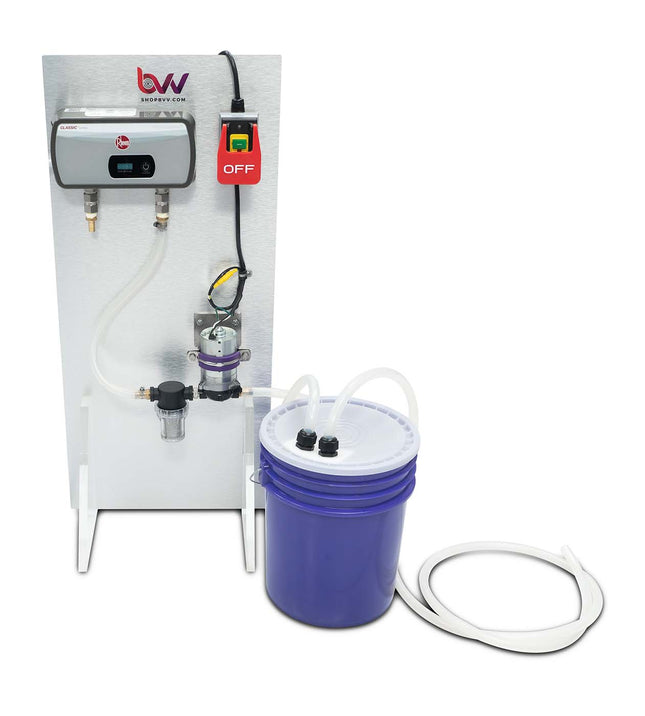

Express Extractor Heater 3.5 to 11KW of heating Power!
Express Extractor Heater by BVV™ 1 Year Warranty, Built in house ready to ship in 24hrs! The BVV™ Extractor Heater is our built in house high power extractor heater circulator. We have 3 model units 3,500, 8,000 & 11,000 WATTS! Each upright panel comes with 25ft of silicone tubing and a 5 gallon reservoir. Each system is capable of heating up to 140°F and can exceed the demand of even the largest extraction vessels. The system operates on an independent nitrile diaphragm pump circulating water @1.5GPM. The pump can self prime up to 11ft. and within a typical extractor this pump is operating around 30-50psi in circulating pressure. BVV Part# KW AMPS Voltage Breaker AMPS Installed Plug Rec. Wire Size Temp. Range EEH-3.5KW 3.5 29 120V (1x30)A L5-30P Plug 10 AWG 120°F EEH-8KW 7.3 33 240V (1x40)A 6-50P 8 AWG 80-140°F (adjustable) EEH-11KW 11 46 240V (2x30)A 6-30P (2x12) AWG 80-140°F (adjustable) EEH-5.5KW 5.5 25 220V (1X25)A 6-30P 10 AWG The 3.5KW unit has a digital temperature display and cannot be adjusted from the standard factory programmed 120°F. During normal recovery operations used with our extractors this fluctuates between 120-157°F. Though there is a lack in temperature accuracy we measure at the extractor base a consistent recovery temperature around 122-125°F. These heater are built with an electrical failsafe that prevents them from operating dry, and will auto shut down if the flow is unexpectedly stopped to protect the unit. The attached in-line filter will prevent any debris from entering the heater. A clogged filter will also prevent the heater from operating. General Extractor Size Heater Recommendations for these Models 0-2lbs Biomass EEH-3.5KW 2-5lbs Biomass EEH-8KW 5-20lbs Biomass EEH-11KW At BVV our favorite model is the 11KW. The unit does require two 240V 30A Single phase circuits, but its now a permanent fixture in or laboratory. Every model will pump out lots of heat for any recovery situation, could you use a 3.5KW heater on a 5 or 10lb unit? Absolutely, Just expect longer times to reach the heaters maximum setting. For example we heated 3x 6"x48" fully jacketed columns to 140°F (heater temp) in about 11 minutes using the 11KW heater. Another example is a 1lb Apollo extractor with a fully jacketed collection base heated to 120°F in about 8-9 min. using the 3.5KW extractor heater. ETL Listed to UL 499 and CSA (Canada) Utilizing all UL approved components for the heater, pump, and emergency stop switches, wiring harnesses, plugs, and electrical housings. The heater arrive with the specified plugs attached, however all of the models can be hardwired directly if you choose not to use a plug. *240V units can be used on 208V single phase with 25% reduced temperature output Express Extractor Heater Quick Start Guide
$1,505.52 - $1,925.67
-
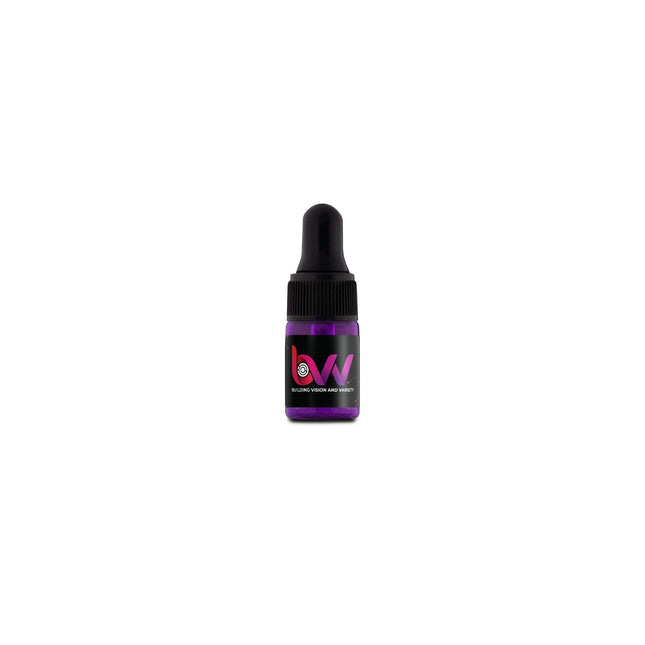

Extract Thinner *Compare to True Terpenes Viscosity
BVV™ Extract Thinner All sales are final. Orders can be refunded prior to fulfillment and shipping but once the order has been fulfilled and/or shipped, no refunds will be issued. Due to the hazardous nature of our product, we are unable to accept returns. BVV™ Extract Thinner is a diluent made from natural terpenes. It does not contain PG, VG, PEG, MCT, Squalane, Squalene, Coconut oil, Triethyl Citrate, or Vitamin E Acetate. Our Extract Thinner will combine with your terpenes and oil and is formulated to minimize flavor and aroma impact. Oure Extract Thinner is not a thickening nor cutting agent and not recommended to be used with CBD. This product is designed to be used with winterized extracts. It is a clear liquid with a faint, odor that will minimally contribute to the aroma and flavor. In order to provide complete transparency and illicit customer confidence, all ingredients are disclosed. INGREDIENTS: Phytol, Beta-Caryophyllene, D-Limonene, Farnesol and Nerolidol Dilution Use Instructions: First infuse your terpene strain or flavor into your winterized extract. Typically 1-5% by volume. Then to use the Extract thinner add 1-3% by Total Volume to thin the extract. Made in the USA by cGMP facilities ISO 9001:2015 Shelf Life: 3 Years Storage Requirements: Keep in the original container, lid securely tightened and away from heat, open flames, sunlight, combustible materials, and hot surfaces. Store in a cool dry place. Improper storage can cause terpenes to degrade.
$22.41 - $392.14
-

Extraction RACK # 2
BVV™ Extraction RACK # 2 (Assembled units come with a 30-day warranty) Note: The unit does not come assembled - select "pre-assembled" from the drop-down menu to have the unit assembled by BVV before shipping Pipe hangers are not included There is no warranty on unassembled units Shipping Notice: If the customer orders the rack as assembled, then the item will only ship via freight and there will be additional shipping charges. Extraction Rack 2 Technical Drawing This rack fits the following BVV™ Extraction Systems: 8.5LB Athena 2LB Little Icarus 5LB Icarus Specifications (Does not include height with casters) Main Base Dimensions 33" X 30" Vertical Dimensions 33" X 48"
$1,050.37 - $1,330.46
-

Extraction RACK # 3
Extraction RACK # 3 (Assembled units come with a 30-day warranty) Note: The unit does not come assembled - select "pre-assembled" from the drop-down menu to have the unit assembled by BVV before shipping Pipe hangers are not included There is no warranty on unassembled units Shipping Notice: If the customer orders the rack as assembled, then the item will only ship via freight and there will be additional shipping charges. Extraction Rack 3 Technical Drawing This rack fits the following BVV™ Extraction Systems: 8.5LB Icarus Poseidon Specifications (Does not include height with casters) Main Base Dimensions 39" X 30" Vertical Dimensions 39" X 48"
$1,190.41 - $1,470.51
-

Extraction RACK # 5
Extraction RACK # 5 (Assembled units come with a 30-day warranty) Note: The unit does not come assembled - select "pre-assembled" from the drop-down menu to have the unit assembled by BVV before shipping Pipe hangers are not included There is no warranty on unassembled units Shipping Notice: If the customer orders the rack as assembled, then the item will only ship via freight and there will be additional shipping charges. Extraction Rack 5 Technical Drawing BVV™ Extraction RACK # 5 is similar to Extraction Rack #3 but with thicker vertical support beams. This rack fits the following BVV™ Extraction Systems: 10LB Mercurius 30LB Closed Loop Extraction System Specifications (Does not include height with casters) Main Base Dimensions 39" X 30" Vertical Dimensions 39" X 48"
$1,365.47 - $1,645.57
-

Extraction RACK # 6
Extraction RACK # 6 (Assembled units come with a 30-day warranty) Note: The unit does not come assembled - select "pre-assembled" from the drop-down menu to have the unit assembled by BVV before shipping Pipe hangers are not included There is no warranty on unassembled units Shipping Notice: If the customer orders the rack as assembled, then the item will only ship via freight and there will be additional shipping charges. Extraction Rack 6 Technical Drawing This rack fits the following BVV™ Extraction Systems: 8.5LB Athena 1LB Icarus 5LB Icarus XL Refinement Filter Stackable Diamond Miner Specifications (Does not include height with casters) Main Base Dimensions 21" X 30" Vertical Dimensions 21" X 36"
$812.28 - $1,092.38
-

Extraction RACK #4
BVV™ Extraction RACK #4 (Assembled units come with a 30-day warranty) Note: The unit does not come assembled - select "pre-assembled" from the drop-down menu to have the unit assembled by BVV before shipping Pipe hangers are not included There is no warranty on unassembled units Shipping Notice: If the customer orders the rack as assembled, then the item will only ship via freight and there will be additional shipping charges. Extraction Rack 4 Technical Drawing This rack fits the following BVV™ Extraction Systems: 2LB Mercurius 5LB Mercurius Specifications (Does not include height with casters) Main Base Dimensions 27" X 30" Side Platform Dimensions 12.5" X 11" Vertical Dimensions 27" X 48" Elevated Platform 27" X 10.5"
$1,008.35 - $1,288.45
-

Extraction RACK #7
Extraction RACK # 7 Rack 7 has 4.5" thick vertical support bars and 3x horizontal bars to complete our strongest standard extraction rack. This rack includes 4x locking caster wheels that can also be adjusted to be level on uneven surfaces. For ease of mounting equipment, we recommend our pipe hangers with hang on brackets Rack Dimensions (L x W x H) 30" x 39" x 60" (Assembled units come with a 30-day warranty) Note: The unit does not come assembled - select "pre-assembled" from the drop-down menu to have the unit assembled by BVV before shipping Pipe hangers are not included There is no warranty on unassembled units Shipping Notice: If the customer orders the rack as assembled, then the item will only ship via freight and there will be additional shipping charges.
$2,310.80 - $2,520.88
-
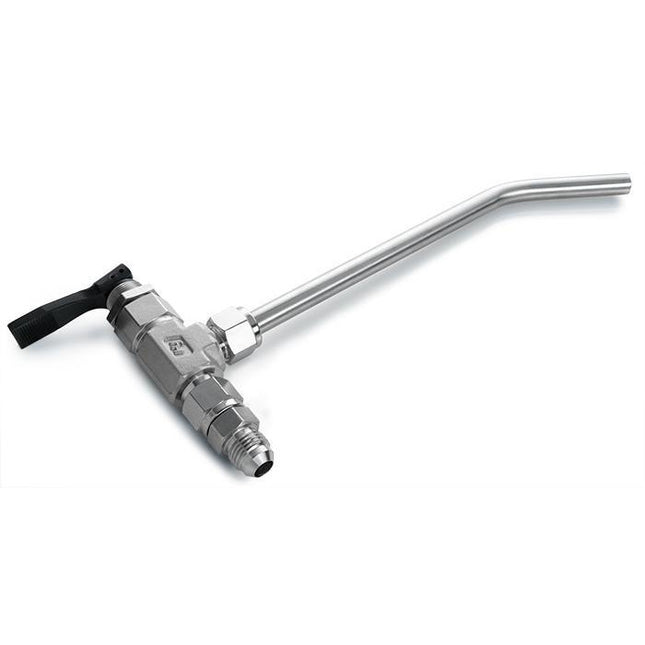
Extractor Dispensing Wand with Toggle Valve - USA SSP Valve
Extractor Dispensing Wand with Toggle Valve This Dispersing Wand is used for dispensing out extracted material without having to lift a heavy collection base and is a lot more controllable when spreading it across a sheet. The valve is a 316L stainless steel compression fitting toggle valve with 3/8" JIC flare and 3/8" diameter x 7" long angled dispersing tube.
$399.14
-
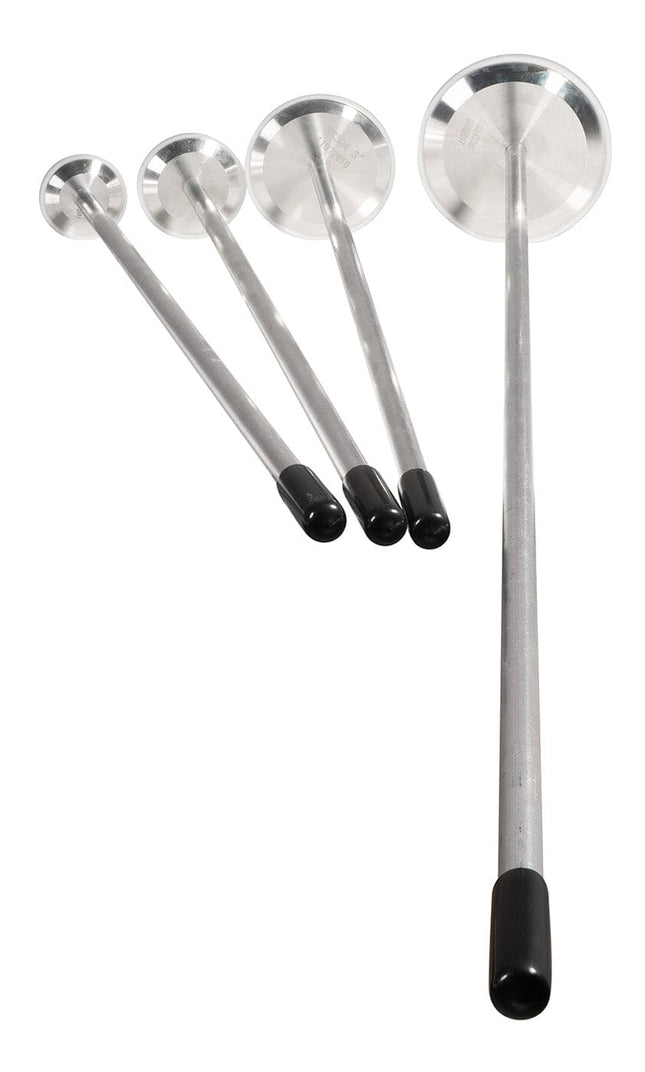

Extractor Material Packing Rod
Extractor Material Packing Rod This affordable and economic tool is throwback to the old days in the BVV lab. This is what we used then and we still use now. Never released for sale until now, we decided we think everyone will like them as much as we do. Simple and sturdy this tool will last as long as ours have; 7 years and more! Constructed of an aluminum shaft with a fixed stainless steel end plate, plastic guard, and stainless hardware. The packing rod is light weight and the added guard makes for a non-scratching design. The best feature is that it will fit the column with a small gap around the circumference and makes packing quick work. Available in 24" and 36" rods. They are not designed to be extendable so if you needed a longer size just send us an email to support@shopbvv.com and we can send you a price quote. For a full stainless steel professional grade packing rod check out this BVV item Stainless Steel Extractor Packing Rod SKU# PROD15024
$36.41 - $61.62
-
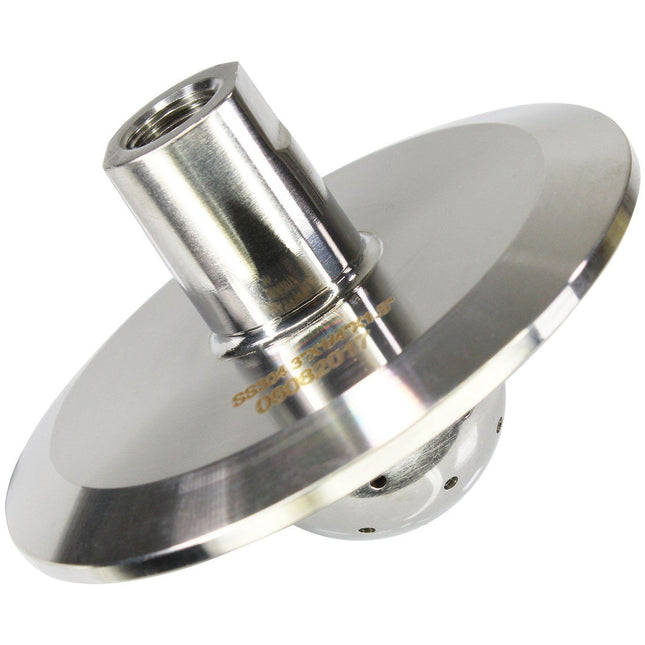

Female NPT Shower Head End Caps
Female NPT Shower Head End Caps Shower Head End Caps Tri Clamp/ Tri Clover help disperse solvent input into a system which creates better material saturation when flooding a material column. This helps to prevent channeling, ensuring all the material is saturated. Specifications: Material: 304 Stainless Steel Connection Type: Tri-Clamp 1/4" - 18 FNPT 3/8" -18 FNPT 1/2" - 14 FNPT Standard: 3A Sizes Available: 1.5" 2" 3" 4"
$42.01 - $86.83
-
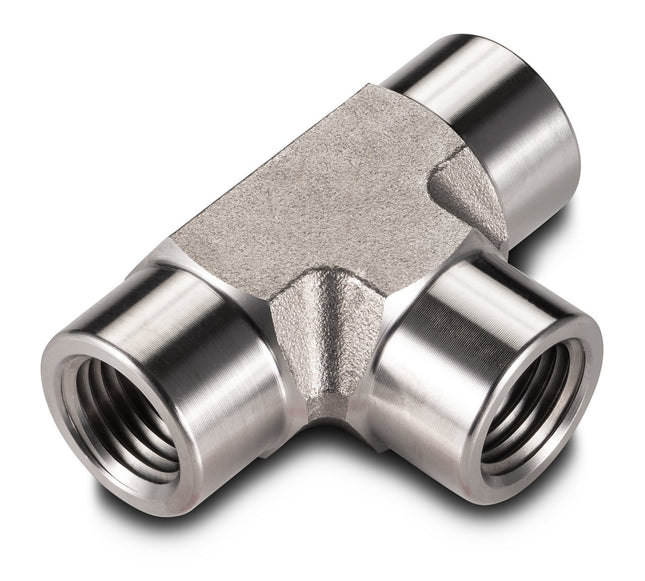

Female Tee
BVV™ Female Tee BVV™ brand stainless steel parts are made with precision 304 Grade Stainless Steel and are clean and free from burrs or debris. These fittings are NPT threads (National Pipe Taper) and will compress against other Female/Male NPT threads creating a tighter and tighter connection. All NPT threads require thread sealant to create a watertight and gas-tight seal between the threads. We recommend using Yellow Gas PTFE Tape because it is rated for gases and is UL listed and it is NOT recommended to use white PTFE tape because it is not rated for gas service. Stainless Steel Female Tees are used to connect 3 Male NPT threaded connections together for either diverting flow in a system or even isolating a section of the extraction system.BVV™ Female Tee - Data Sheet Specifications Material 304 Stainless Steel Connection Type(s): 1/4"-18 FNPT 3/8"-18 FNPT Sizes Available: 1/4" 3/8"
$28.01 - $49.02
-

FEP Sheet 4" x 4"
FEP is used for its high temperature (ability to handle live steam up to 30 psig) low friction properties, and wide-ranging chemical resistance and a very high (92%) UV transparency. A relatively high breakdown voltage makes it an excellent insulator. The superb release properties of FEP, combined with an upper continuous use temperature of up to 4500F makes it the best cost-effective solution for applications where low friction, non-stick contact is necessary. Examples include food processing, packaging, medical devices, laboratory and wet benches, paint handling, and fluid sample evaluations. FEP can be used for application under cryogenic conditions. Attributes Size: 4" x 4" Selected grades of FEP comply with FDA 21CFR.177.1550 USP Class VI approved Tolerance Thickness: -0.000/+20%.
$14.00 - $49.02
-

Fiberglass Insulation Rope 10 Feet
Fiberglass Insulation Rope 10 Feet ***Caution: Always use proper protection when working with fiberglass. Avoid skin and eye contact.*** Ten feet of white 1/2" fiberglass insulation rope. Used to wrap the upper half of boiling flasks. Specifications: Width: 1/2" Material: Fiberglass Maximum Temperature: 1000F Resistant to solvents, acids, and bleach Color: White Length: 10 ft. (20ft needed for 5L Flask.)
$42.01
-
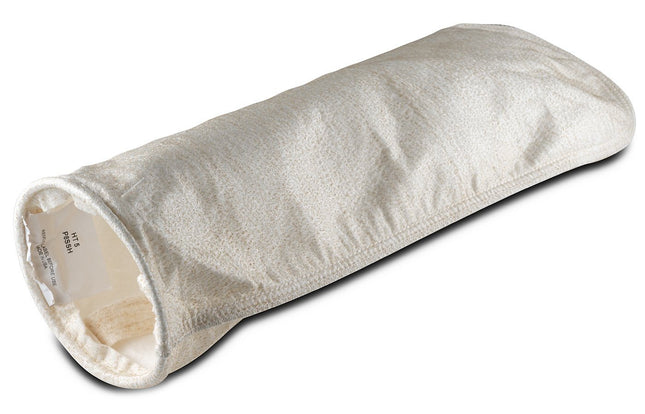

Filter Bag for Petroleum Oil and Organic Solvents
These filter bags come in a wide variety of micron levels and are specifically designed for BVV Pressure Filtration Systems. They are made of nylon fabric and range from 1 micron to 100 micron. For use with the following systems: Cryogenic 45L Centrifuge Extractor Kit Pressure Filtration System - 6 x 28 Trade Size #8 *Note: metal mesh cage not included - for reference only.
$70.02 - $82.63
-
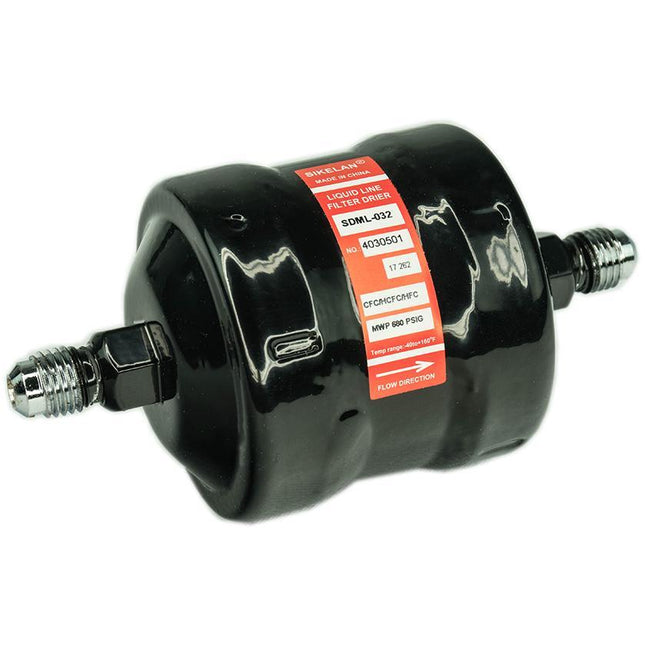
Filter Dryer
BVV Filter Dryer (Compare to Mastercool 69500-DR Filter Dryer) 1/4" In-Line Liquid filter drier model SDML-032 DM Core - 100% molecular sieves recommended for HFC's with POE and PAG oils.
$21.01
-
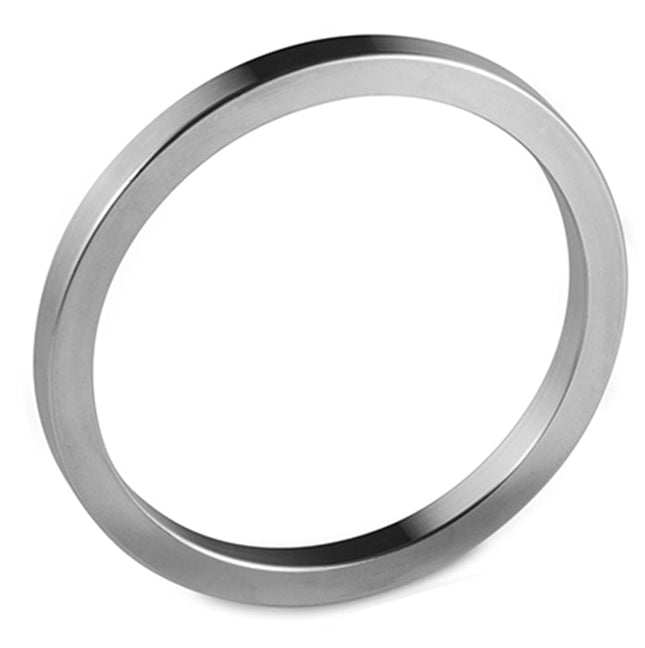
Filter Plate Ring
Filter Plate Ring *Note: Only 1 Ring Included per Order. Increase Quantity for more Rings. These filter plate rings allow the user to stack different levels of filtration inside their system. They are made out of 304 stainless steel and will easily drop inside of any Tri-Clamp/ Tri Clover column or filter plate.
$16.81 - $67.22
-
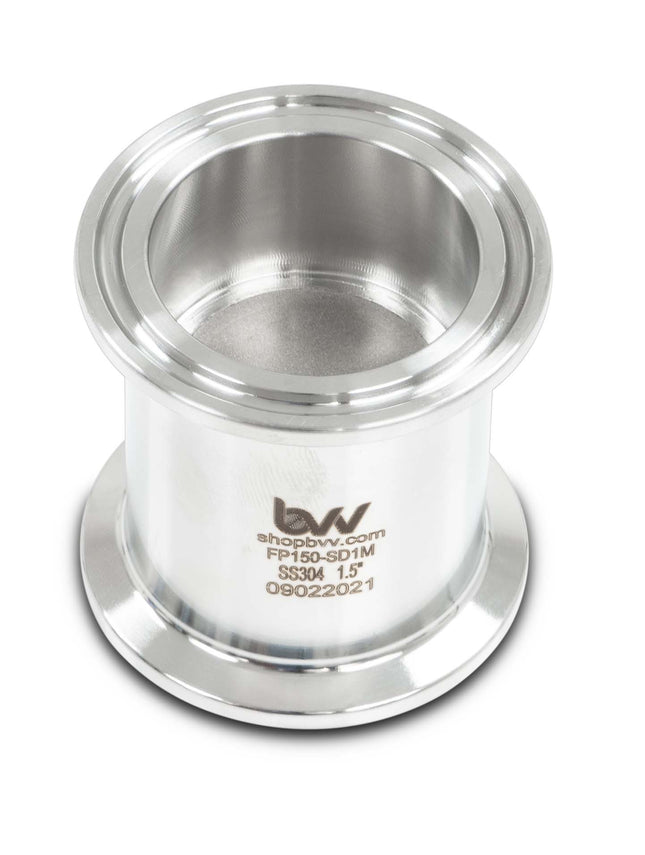

Filter Plate with Built-In Sintered Disk
Filter Plate with Built-In Sintered Disk / Tri Clover Filter Plate These filter plates offer the user a great solid platform to help with filtration during the extraction process with a welded in sintered filter disk with hexagon backing. These filter plates can be used simultaneously with ashless filter papers or any other filtration media like stainless steel ball bearings or steel wool to increase surface and filtration level to remove fats, lipids, waxes and any other unwanted material during the extraction process. **Note: Does not include Clamp or Gasket Sizes Available: 1.5" 2" 3" 4" 6" 8" 10" 12" Specifications: Material 304 Stainless Steel Standard 3A High Polish Connection Type(s) Tri-Clamp Hole Diameter 5.8mm Height 2"
$100.84 - $700.24
-


Fireplace Fuel Clean Burning, Odorless, and Smokeless Grain Ethanol, Fuel for Table Top Fire Pit
Fireplace Fuel Made in USA - From Grain Alcohol Bright Flame fireplace fuel contains two ingredients and were open about sharing our fuel recipe. The mixture is made from grain derived corn based ethanol and there is about 7.8% Isopropyl Alcohol added for enhanced flame ambiance. Ethanol 200 Proof - 87.49% by Wt% (CAS# 64-17-5) Isopropyl Alcohol (IPA) - 7.8% by Wt% (CAS# 67-63-0) Fireplace Fuel Safety Data Sheet (SDS)
$18.19 - $126.03
-
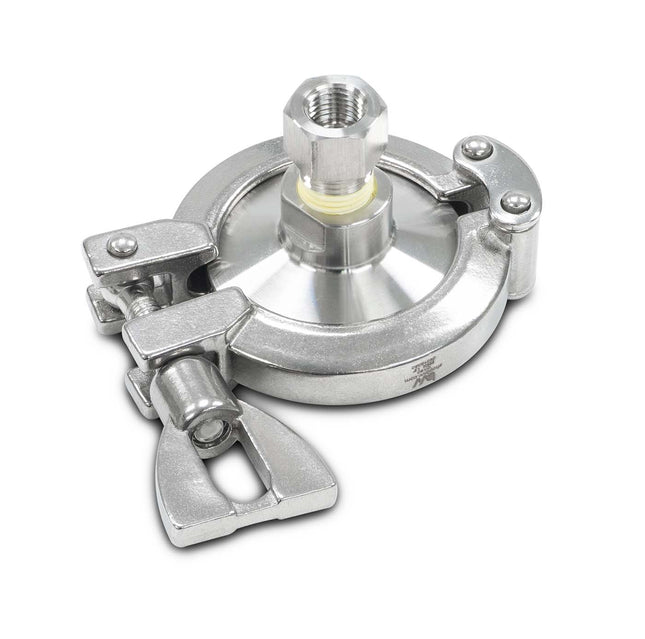

FJIC X 3MM Can Adapter
FJIC X 3MM Can Adapter This adapter allows the user to seamlessly inject canned solvent into a standard 1/4" MJIC connection without releasing solvent to the atmosphere. This FJIC to 3MM adapter conveniently screws onto any 1/4" MJIC connection allowing for the safe injection of canned solvent into a closed loop system.
$49.02 - $51.82
-
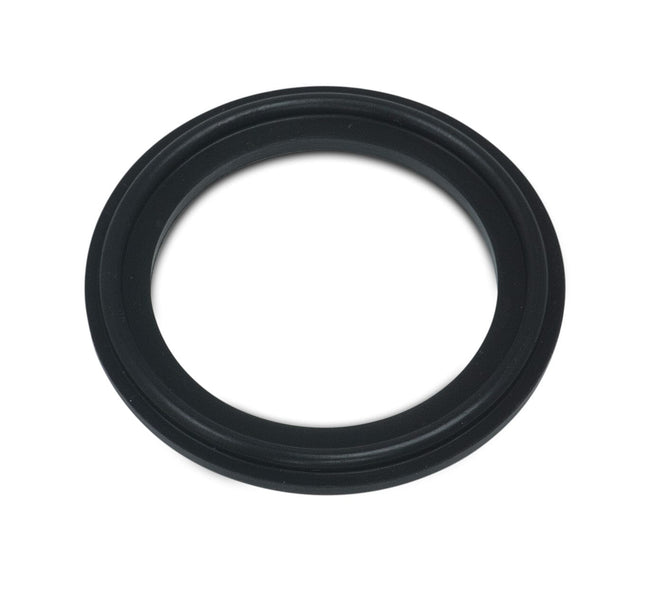

FKM Viton Tri-Clamp Gaskets
FKM Viton Tri-Clamp Gaskets Fluoroelastomer (FKM) gaskets are a great option for using higher temperatures in a closed-loop system or other steps of the extraction process including filtration and decarbing. FKM offers an excellent chemical compatibility with numerous solvents. FKM Gaskets offer a higher temperature rating and better chemical compatibility than Buna rubber. Key Features: High-temperature range Better compressibility and springiness Excellent resistance to butane and propane Better tear resistance Better chemical resistance USP Certified FDA CFR 177.2600 – Rubber and Rubber-Like Material for Repeated Use/Contact with Food. FDA CFR 177.1550 – Fluorocarbon Resins for Repeated Use/Contact With Food, Dairy & Pharmaceutical Products. Sizes Available: 1.5" 2" 3" 4" 6" 8" - easy on flanged 10" - easy on flanged 12" - easy on flanged Technical Specifications: Material: Viton (FKM) Color: Black Connection Type: Tri-Clamps Conformance: FDA Compliant / Meets 3A Standards Thermal Properties: -Low Temperature Range -49°F -Minimum For Continuous Use (Static) -15°F -Brittle Point -49°F -High Temperature Range +400°F -Maximum for Continuous Use (Static) +400°F Gas Permeability: Excellent Chemical Compatibility: Butane A - Excellent Propane (liquified) A - Excellent Alcohols: -Amyl A - Excellent -Benzyl A - Excellent -Butyl A - Excellent -Diacetone D - Severe Effect -Ethyl A - Excellent -Hexyl C - Fair -Isobutyl B - Good -Isopropyl A - Excellent -Isopropyl A - Excellent -Methyl C - Fair -Octyl B - Good -Propyl A - Excellent BVV is not responsible if incompatible chemicals, solvents, or operating temperatures are used in the user's system.
$5.60 - $119.04
-

Flask Tongs
Flask Tongs These flask tongs are great when handling any glassware that is too hot to handle or off-gassing and allows the user to handle the flask or beaker at a safe distance with ease. These tongs are a 2 finger design with nickel plated metal and rubber coated fingers with an overall length of 10.5".
$7.00
-
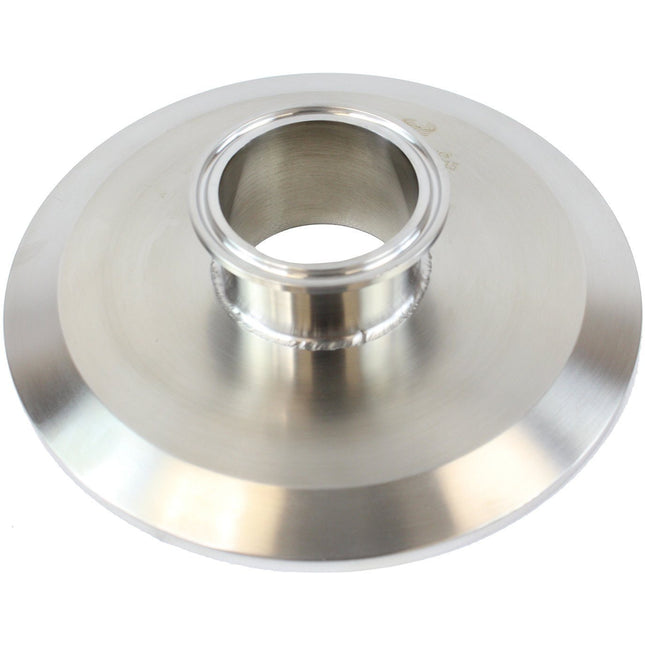

Flat Tri-Clamp Reducer
Flat Tri-Clamp/Tri-Clover Reducers Flat Tri-Clamp reducers allow the user to connect differently sized Tri-Clamp parts to each other without adding to the overall size of your extraction system. These reducers are offered in Tri-clamp x Tri-Clamp connections Sanitary Fittings end cap reducers are often used as an increaser flowing from smaller to a larger diameter which makes them suitable in horizontal flow applications, available in eleven sizes. Specifications: Material: 304 Stainless Steel High Polish Interior Standard: 3A Connection Type : Tri-Clamp x Tri-Clamp
$33.61 - $196.07
-
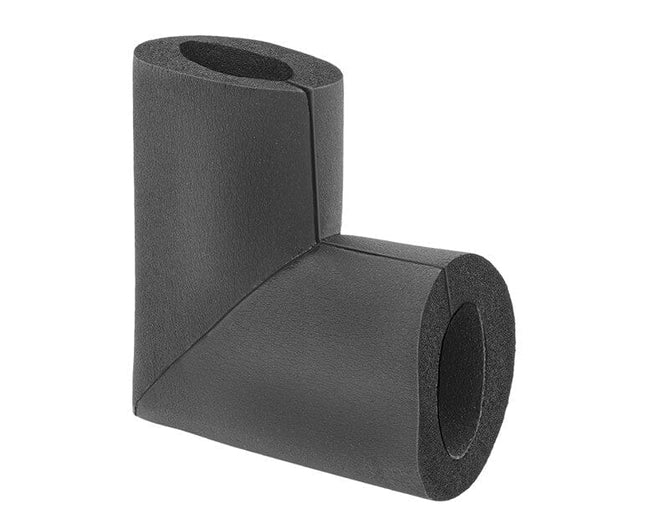
Flexible Rubber Foam Pipe Insulation Elbow, 1/2" Thick Wall, 1-3/8" ID
Flexible Rubber Foam Pipe Insulation Elbow Soft and easy to install, this insulation restricts absorption of water, air, and gas. It is often used on cold and hot water lines and refrigeration lines. Seal with contact adhesive (sold separately). To use outdoors, coat in acrylic paint. For Use On Pipe Insulation Type Elbow Elbow Bend 90° Wall Thickness 1/2" ID 1 3/8" OD 2 3/8" For Pipe Size 1 For Copper Tube Size 1 1/4 Temperature Range -295° to 220° F Heat Flow Rate 0.25 Btu @ 75° F Density 4.5 lbs./cu. ft. Material Buna-N/PVC Foam Color Black Flexibility Flexible Cell Type Closed Tube Style Slit Specifications Met ASTM E84 25/50 for Flame and Smoke, ASTM C534 Performance Properties Moisture Resistant R Value 2 Additional Specifications SDS RoHS RoHS 3 (2015/863/EU) Compliant REACH REACH (EC 1907/2006) (01/17/2022, 223 SVHC) Compliant DFARS Specialty Metals COTS-Exempt Country of Origin United States USMCA Qualifying No Schedule B 392690.9988 ECCN EAR99
$16.11
-

Flexible Rubber Foam Pipe Insulation Sheet with Plain Backing, 4 Feet Long x 36" Wide x 1/2" Thick
Temperature Range:Plain Backing: -295° to 220° FAdhesive Backing: 20° to 180° F Heat Flow Rate: See Table Density: See Table Color: See Table Specifications Met: See Table
$112.04
-
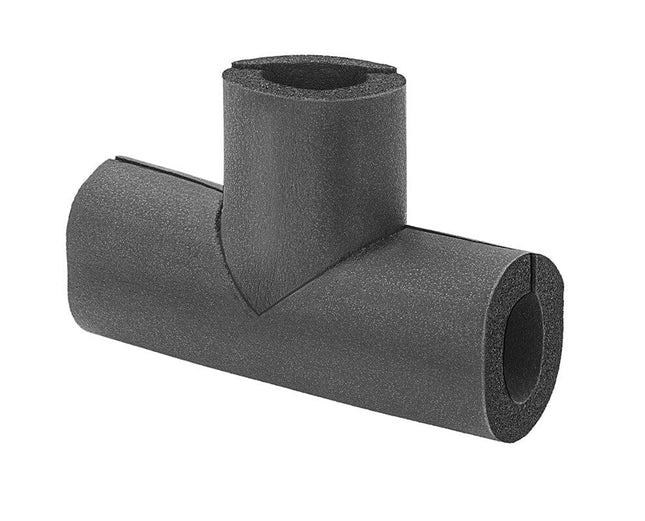
Flexible Rubber Foam Pipe Insulation Tee, 1/2" Thick Wall, 1-3/8" ID
Flexible Rubber Foam Pipe Insulation Tee Soft and easy to install, this insulation restricts absorption of water, air, and gas. It is often used on cold and hot water lines and refrigeration lines. Seal with contact adhesive (sold separately). To use outdoors, coat in acrylic paint. For Use On Pipe Insulation Type Tee Wall Thickness 1/2" ID 1 3/8" OD 2 3/8" For Pipe Size 1 For Copper Tube Size 1 1/4 Temperature Range -295° to 220° F Heat Flow Rate 0.25 Btu @ 75° F Density 4.5 lbs./cu. ft. Material Buna-N/PVC Foam Color Black Flexibility Flexible Cell Type Closed Tube Style Slit Specifications Met ASTM E84 25/50 for Flame and Smoke, ASTM C534 Performance Properties Moisture Resistant R Value 2 Additional Specifications SDS RoHS RoHS 3 (2015/863/EU) Compliant REACH REACH (EC 1907/2006) (01/17/2022, 223 SVHC) Compliant DFARS Specialty Metals COTS-Exempt Country of Origin United States USMCA Qualifying No Schedule B 392690.9988 ECCN EAR99
$21.01
-

Flexible Rubber Foam Pipe Insulation Tube Slit, 1/2" Thick Wall, 1-5/8" ID, 6 Feet Long
Temperature Range: -295° to 220° F Heat Flow Rate: 0.25 Btu @ 75° F Density: 4.5 lbs./cu. ft. Color: Black Specifications Met: ASTM E84 25/50 for Flame and Smoke, ASTM C534
$53.22
-
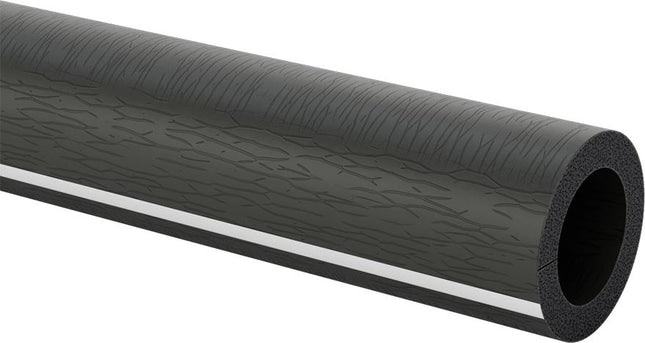

Flexible Rubber Foam Pipe Insulation Tube Slit, 1/2" Thick Wall, 1-7/8" ID, 6 Feet Long
Flexible Rubber Foam Pipe Insulation Tube Soft and easy to install, this insulation restricts absorption of water, air, and gas. It is often used on cold and hot water lines and refrigeration lines. Seal with contact adhesive (sold separately). To use outdoors, coat in acrylic paint. Slit tubes have an adhesive strip closure. For Use On Pipe Insulation Type Tube Wall Thickness 1/2" ID 1 7/8" OD 2 7/8" For Pipe Size 1 1/2 Length 6 ft. Temperature Range -295° to 180° F Heat Flow Rate 0.25 Btu @ 75° F Density 4.5 lbs./cu. ft. Material Buna-N/PVC Foam Color Black Closure Type Adhesive Strip Flexibility Flexible Cell Type Closed Tube Style Slit Specifications Met ASTM E84 25/50 for Flame and Smoke, ASTM C534 Performance Properties Moisture Resistant R Value 2 Additional Specifications SDS RoHS RoHS 3 (2015/863/EU) Compliant REACH REACH (EC 1907/2006) (06/10/2022, 224 SVHC) Compliant DFARS Specialty Metals COTS-Exempt Country of Origin United States USMCA Qualifying No Schedule B 400911.0000 ECCN EAR99
$61.62
-
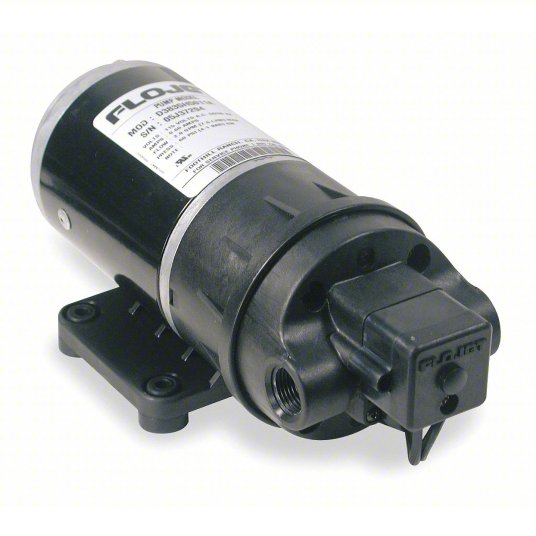
FLOJET On-Demand General Purpose Diaphragm Pump: D3835H5011A, Polypropylene, Ethylene Propylene
BrandFLOJET Current0.6 A Number of Diaphragms2 Diaphragm MaterialEthylene Propylene Discharge Connection Size3/8 in Discharge Connection TypeFNPT Maximum Flow Rate2 gpm Housing MaterialPolypropylene Intake Connection Size3/8 in Intake Connection TypeFNPT Manufacturer Part NumberD3835H5011A Max. Media Temperature140 °F Nameplate Voltage120V AC Overall Height3.6 in Overall Length7.9 in Overall Width3.2 in Demand Pressure SwitchNo SeriesDuplex II StandardsCE Certified; CSA Certified; UL Listed Suction Port3/8 in FNPT Discharge Port3/8 in FNPT Max. Discharge Pressure100 psi PrimingSelf-Priming Check Valve MaterialEPDM UNSPSC40151548 Country of OriginMexico (subject to change) Product Description Bypass electric sprayer pumps run constantly, even if the discharge port is closed. Bypass electric sprayer pumps are suited for applications where various flow and pressure rates are needed or applications that have multiple discharge points, such as spray bars.
$389.34 $266.09
-
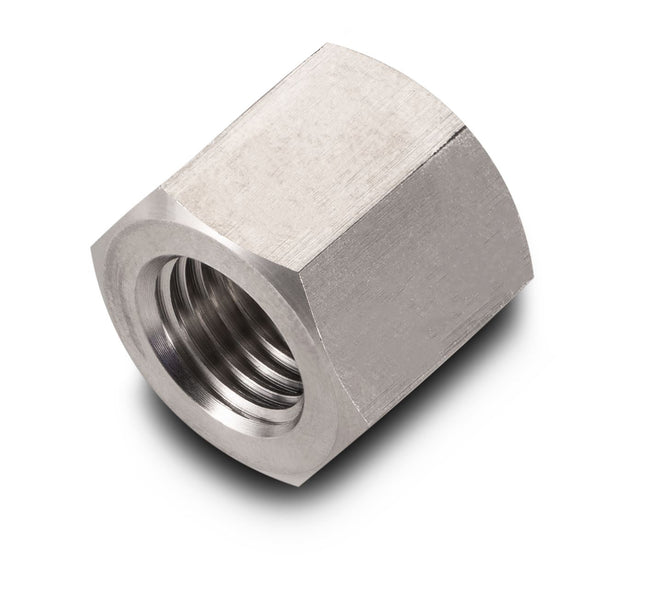

FNPT Cap
BVV™ FNPT Cap Best Value Vacs brand stainless steel parts are made with precision 304 Grade Stainless Steel and are clean and free from burrs or debris. These fittings are NPT threads (National Pipe Taper) and will compress against other Female/Male NPT threads creating a tighter and tighter connection. All NPT threads require thread sealant to create a watertight and gas-tight seal between the threads. We recommend using Yellow Gas PTFE Tape because it is rated for gases and is UL listed and it is NOT recommended to use white PTFE tape because it is not rated for gas service. Female NPT caps are designed for capping off male NPT threaded connections on extraction systems. Specifications Material 304 Stainless Steel Connection Type 1/4"-18 FNPT 3/8"-18 FNPT 1/2"-14 FNPT Sizes Available: 1/4" 3/8" 1/2"
$5.60
-
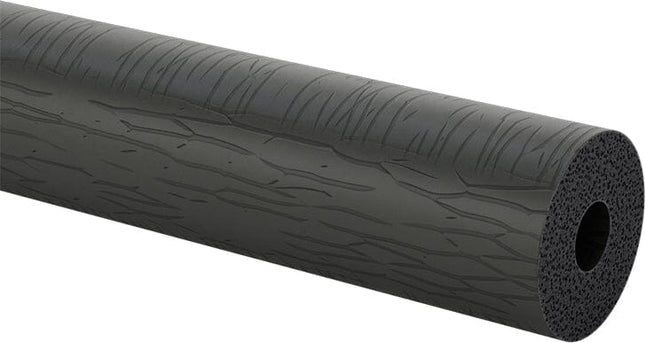

Foam Insulation for Hose and Tubing - 6 Feet
Foam Insulation for Hose and Tubing - 6 Feet This foam insulation is good for silicone tubing, stainless steel braided hosing, compression hard line tubing, and more! The inner diameter of the foam can be 3/8", 1/2", or 5/8" and must be selected in the drop down menu. This should correspond with the outer diameter of the hose that you want to insulate. The 3/8" option will slide on your hose or tube while the 1/2" and 5/8" options have a taped seam. All options come in 6' lengths. Sizing Chart: Foam Insulation Size: 3/8" 1/2" 5/8" For Compression Tube Size 3/8" 1/2" - For Stainless Steel Braided Hose Size 3/8" * 1/2" - For Silicone Tube Size 1/4" 3/8" 1/2" Composition Nitrile, PVC Flame/Smoke Rating 25/50 Height 1.375 Insulation Nominal I.D. 3/8" Length 72 R-Value R4.1 Temperature Range -297°F to 220°F (-182.78°C to 104.44°C) Country of Origin USA * The 3/8" foam does not have a seam and cannot be easily slid over stainless steel braided hose with permanent end fixtures.
$47.62 - $63.02
-

$280.10
-


Formaldehyde 37% Lab Grade
Formaldehyde 37% Stabilized with 11% Methanol | Laboratory Grade Our Formaldehyde is a clear colorless liquid with a strong odor. Formaldehyde is used in a variety of industrial applications. It can be used as a preservative, disinfectant, and as an additive in production of adhesives, plastics, and textiles. Formaldehyde 37% M 11% Certificate of Analysis (COA) Formaldehyde 37% M 11% Safety Data Sheet (SDS) Chemical Formula: CH2O Molecular Weight: 30.026 g/mol CAS Registry Number: 50-00-0, 67-56-1 Appearance: Colorless Liquid Odor: Pungent Density 1.08 g/ml Boiling Point: 122.58 °F (50.32 °C) estimated Solubility in water: Completely Soluble GHS Pictograms: GHS Signal Word: Danger GHS Hazard Statements: H226, H301 + H311, H314, H317,H330, H335, H341, H350, H370, H401 GHS Precautionary Statements P201, P202, P210, P233, P240, P241, P242, P243, P260, P264, P270, P271, P272, P273, P280, P284, P301 + P310 + P330, P301 + P330 + P331, P303 + P361 + P353, P304 + P340 + P310, P305 + P351 + P338 + P310, P308 + P313, P361 + P364,P370 + P378, P403 + P233, P403 + P235, P405, P501 UN Identification Number: 2209 Proper Shipping Name: Formaldehyde Solution Transport Hazard Class: 8 Packing Group: III DOT Placard:
$19.61 - $700.24
-
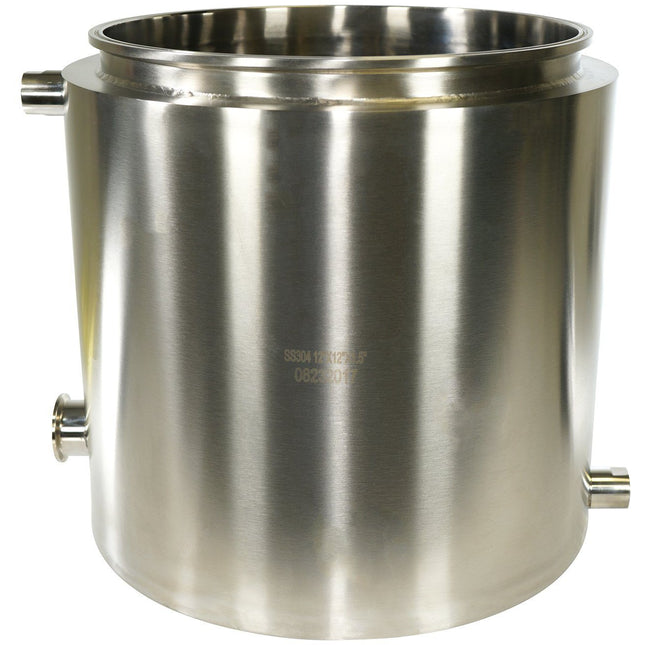

Fully Jacketed Base with 1.5" Tri-Clamp Drain Port
Fully Jacketed Base with 1.5" Tri-Clamp/ Tri-Clover Drain Port This Fully Jacketed Base features a full outer jacket to allow the circulation of heat transfer fluid. The base also has a sanitary Tri-Clamp port welded through the jacket and base for easier drainage of processed material and extract from the stainless steel base. This base is made out of 304 High Polish Stainless steel and has 2 1/2" FNPT Ports on the outer jacket to allow the circulation of fluid to heat or chill the base and also has a 1.5" Tri-Clamp port that allows the drainage of material from inside the base without having to lift it up and tip it over. Specifications Material 304 Stainless Steel Sizes Available: 10" Tri-Clamp X 12" 12" Tri-Clamp x 12" Drain Port Size 1.5" Tri-Clamp Jacket Port Size 1/2" FNPT
$630.22 - $770.27
-
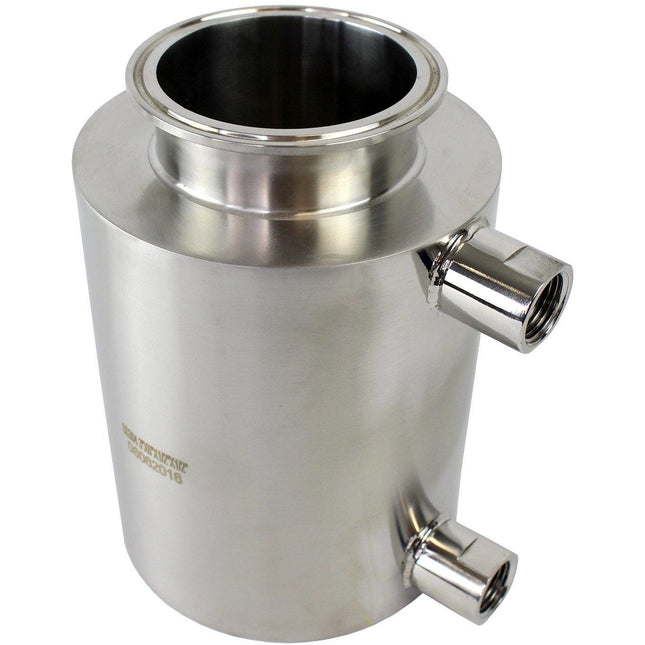

Fully Jacketed Containers
Fully Jacketed Containers Fully jacketed containers are designed to be used as collection pots or collection traps in an extraction system and they allow the circulation of temperature control fluid through the outer welded jacket that has 1/2" FNPT ports to adapt several types of connections too. These Containers are made out of 304 Stainless steel and have Sanitary welds on them.
$329.11 - $609.21
-
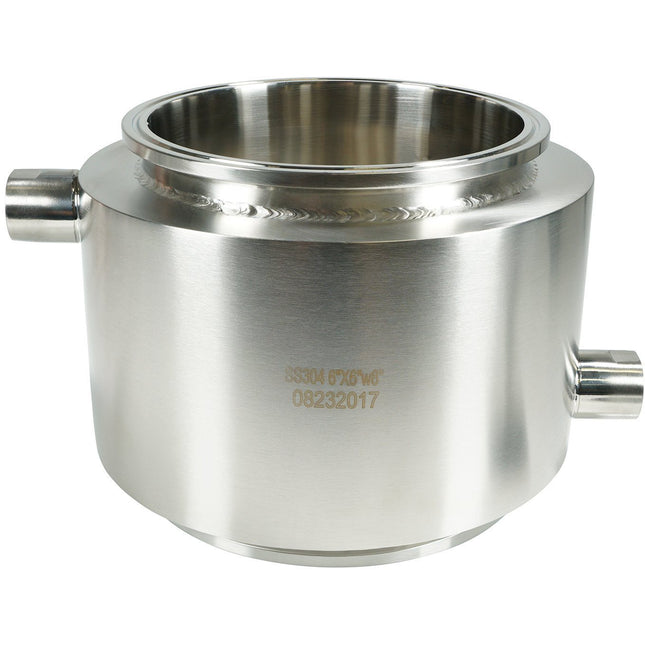
Fully Jacketed Spools
Fully Jacketed Spools 304 Stainless Steel Fully Jacketed Spools allow the user to circulate water through the base of an extractor or the material column to heat up or chill solvent vapor. Has 1/2" FNPT ports. And attached tri clamp fittings on each end for user convenience. BVV™ Fully Jacketed Spools - Drawings
$154.05 - $952.33
-
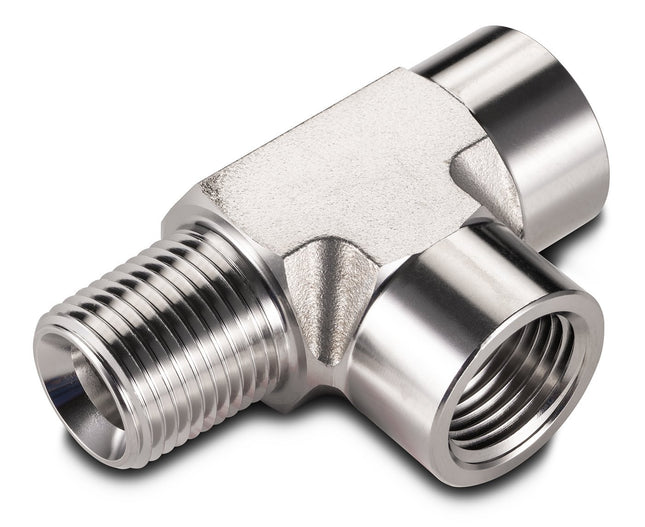

FxFxM Street Tee
BVV™ FxFxM Street Tee BVV™ brand stainless steel parts are made with precision 304 Grade Stainless Steel and are clean and free from burrs or debris. These fittings are NPT threads (National Pipe Taper) and will compress against other Female/Male NPT threads creating a tighter and tighter connection. All NPT threads require thread sealant to create a watertight and gas-tight seal between the threads. We recommend using Yellow Gas PTFE Tape because it is rated for gases and is UL listed and it is NOT recommended to use white PTFE tape because it is not rated for gas service. **NOTE: Pre-Taped option comes from BVV Pre-taped with Yellow UL Listed Gas PTFE Tape on the Male NPT threads ONLY for a +0.50c charge per male npt end. (JIC Threads DO NOT need to be taped.) FxFxM Street Tees have 2 Female NPT ports and 1 Male NPT port and depending on the configuration of the application these street tees may offer fewer connection points or better configurability than MxMxF street tees. BVV™ FxFxM Street Tee - Data Sheet
$25.21 - $49.02
-

Gas PTFE Tape
Gas PTFE Tape Yellow gas line PTFE Tape is used for hydrocarbon extraction systems and mandatory for any system with solvents. The PTFE tape is a thick threaded sealant that can be used on different plastic and metal pipes. This easy to use tape can be used to help prevent cross threading and form a leak proof seal. Suitable for lines carrying water, oil, gas, and propane. Pressure rating 10,000 PSI.
$7.70 - $9.80
-
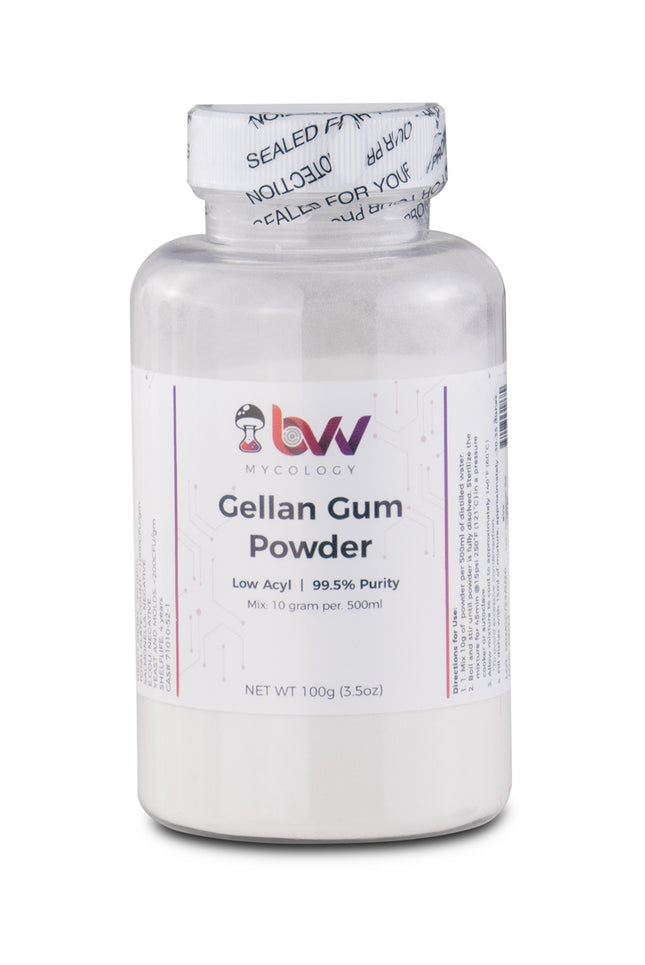
Gellan Gum Powder for Mushrooms Mycology
Gellan Gum Powder Low Acyl | 99.5% Purity Gellan Gum is a high- molecular weight polysaccharide gum that is a product of fermentation of carbohydrates by pseudomonas Elodea which is purified, dried and powdered. Gellan gum is ideal for most microbial and plant tissue culture applications. It’s gelling property makes it a viable ingredient of jellies, beverages, dairy products etc.. This superfine gellan gum dissolves quickly and has a high gel strength making it an excellent choice for a variety of applications an petri dishes. STORAGE: Cool dry conditions, sealed original package Mix: 10gram per. 500ml GELLANGUM CONTENT: 99.5% PARTICLE SIZE 60MESH: 99.0% TRANSPARENCY: 86.3% GEL STREGNTH: 980gm/cm^2 pH: 6.5 TURBIDITY: 8.0NTU HEAVY METAL: <20 ppm. TOTAL PLATE COUNT: <1000CFU/gm SALMONELLA: NEGATIVE E.COLI: NEGATIVE YEAST AND MOLDS: <200CFU/gm SHELFLIFE: 4 years CAS#71010-52-1 Directions for Use: Mix 10g of powder per 500ml of distilled water. Boil and stir until powder is fully dissolved. Sterilize the mixture for 45min @15psi 250°F (121°C) in a pressure cooker or autoclave. Allow mixture to cool to approximately 140°F (60°C) *To avoid excessive condensation. Fill dishes with 15ml of mixture, approximately ~30-35 dishes.
$18.21 - $89.63
-
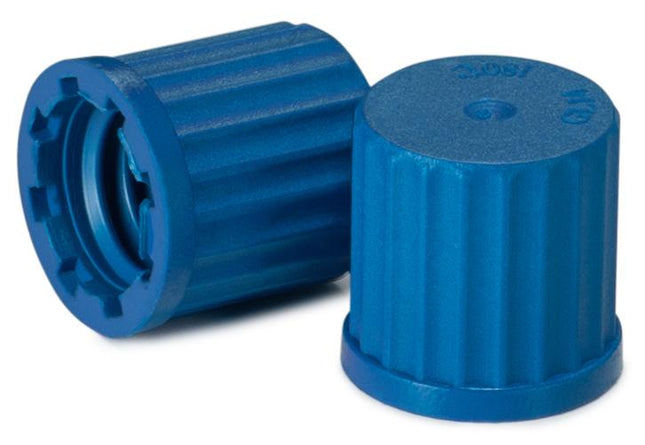

GL-14 Cap
GL-14 Cap This GL-14 cap is used for sealing off GL-14 connections or venting vacuum in a system without the use of a valve. Gasket not included. (Note: Only 1 cap included. Increase quantity to order more caps.)
$8.40
-


Glacial Acetic Acid 99.8% Food Grade
BVV™ Food Grade Glacial Acetic Acid 99.8% pH: 2.4 Looking for a food-grade acid for your acid-base extraction? Our premium Glacial Acetic Acid is precisely what you need! As a leading supplier of high-purity solvents & chemicals, we provide the purest Glacial Acetic Acid available for your acid-base extraction and pH adjustment needs, ensuring exceptional results every time. Acetic acid, also known as ethanoic acid, is a versatile organic compound that plays a significant role in various industries and everyday life. It is a colorless liquid with a pungent, vinegar-like odor. Acetic acid (CH3COOH) is a weak acid that is highly soluble in water and many organic solvents. Due to its unique properties, acetic acid is widely used as a solvent, preservative, and flavoring agent in the food and beverage industry. It is also a key component in the production of vinyl acetate, which is used in the manufacturing of adhesives, coatings, and textiles. Furthermore, acetic acid is utilized in the synthesis of numerous chemicals, including pharmaceuticals, dyes, and plastics. Its diverse range of applications makes acetic acid an essential compound in many industrial processes, where it contributes to the creation of countless products that we encounter in our daily lives. Glacial Acetic Acid, also known as ethanoic acid, is a highly concentrated and pure form of acetic acid. Its name, "glacial," refers to its ability to freeze at a relatively low temperature (16.6C/61.9F). This characteristic sets it apart from other forms of acetic acid, making it ideal for various industrial applications, including acid-base extraction. Our Glacial Acetic Acid contains less than 1% water and is also considered water-free anhydrous acetic acid. In acid-base extraction, Glacial Acetic Acid serves as an essential component due to its unique properties. It acts as a weak acid, enabling the extraction of alkaline compounds from organic mixtures. With our premium Glacial Acetic Acid, you can achieve efficient separation of target compounds by adjusting the pH and facilitating the formation of soluble salts. In addition to its use in acid-base extraction, our Glacial Acetic Acid finds widespread application in various industries, including pharmaceuticals, textiles, and food processing. It is also known for its ability to dissolve and remove mineral deposits, making it an excellent choice for descaling and cleaning applications. At BVV, we take pride in delivering premium solvents, chemicals, and adsorbents that exceed customer expectations. Our team of experts is always available to provide personalized support and guidance, ensuring that you find the right solution for your needs. With our high-purity Glacial Acetic Acid & Sodium Hydroxide, you can optimize your acid-base extraction processes and pH adjustment needs to achieve exceptional results. Ready to elevate your acid-base extraction procedures? Order our High Purity Glacial Acetic Acid & Sodium Hydroxide today and experience its superior quality and performance firsthand. Contact us now to learn more and take advantage of our competitive prices and prompt delivery. Unlock the potential of your acid-base extractions with BVV! Chemical Formula: CH3COOH Molecular Weight: 60.052 g·mol−1 CAS Registry Number: 64-19-7 Appearance Colorless, transparent liquid, Odor: Heavily vinegar-like Density 1.049 g/cm3 (liquid); 1.27 g/cm3 (solid) Boiling Point: 16 °C / 61°F GHS Pictograms: GHS Signal Word: Danger GHS Hazard Statements: H226, H314 GHS Precautionary Statements P280, P305+P351+P338, P310 UN Identification Number: 2789 Proper Shipping Name: Acetic Acid, Glacial Transport Hazard Class: 8 Packing Group: II DOT Placard: What is Acetic Acid? Acetic acid, also known as ethanoic acid, is a colorless liquid organic compound with a distinct sour taste and pungent smell. It is a member of the carboxylic acid family and is classified as a weak acid due to its partial ionization in aqueous solutions. Acetic acid is a fundamental building block in various chemical reactions and is commonly found in vinegar, giving it its characteristic sour taste. Chemically represented as CH3COOH, acetic acid consists of two main components: a carboxyl group (-COOH) and a methyl group (-CH3). It is produced naturally through fermentation processes, where bacteria convert ethanol into acetic acid. Additionally, acetic acid can be synthesized through various chemical methods for industrial applications. Acetic acid is widely utilized in various industries, including food, pharmaceuticals, textiles, and chemicals. It serves as a crucial ingredient in the production of plastics, solvents, dyes, and synthetic fibers. Its versatile nature makes it an essential component in countless products and processes, contributing to a wide range of applications across different sectors. What Is Acetic Acids Formula? Chemically represented as CH3COOH, acetic acid consists of two main components: a carboxyl group (-COOH) and a methyl group (-CH3). It is produced naturally through fermentation processes, where bacteria convert ethanol into acetic acid. Additionally, acetic acid can be synthesized through various chemical methods for industrial applications. What is Acetic Acids Structure? The structure of acetic acid consists of two carbon atoms (C), four hydrogen atoms (H), and two oxygen atoms (O) arranged in a specific pattern. It forms a molecule with a central carbon atom bonded to two oxygen atoms: one oxygen atom is double-bonded to the carbon (C=O) and the other is bonded via a single bond (C-OH). This arrangement creates a carboxyl group (COOH) at one end of the molecule. The remaining carbon and hydrogen atoms are bonded in a linear chain, resulting in the overall molecular structure of CH3COOH. What Is Acetic Acids Molar Mass? The molar mass of a chemical compound is a measure of the mass of one mole of that substance, expressed in grams per mole (g/mol). For acetic acid (CH3COOH), which is a simple organic compound, the molar mass is calculated by adding up the atomic masses of all the individual atoms in its chemical formula. Let's break down the components of acetic acid: Carbon (C) - Atomic mass: 12.01 g/mol Hydrogen (H) - Atomic mass: 1.01 g/mol (there are 2 hydrogen atoms) Oxygen (O) - Atomic mass: 16.00 g/mol (there are 2 oxygen atoms) Another Oxygen (O) - Atomic mass: 16.00 g/mol Hydrogen (H) - Atomic mass: 1.01 g/mol (there is 1 hydrogen atom) Now, add up the atomic masses: 12.01 g/mol (C) + 1.01 g/mol (H) + 1.01 g/mol (H) + 16.00 g/mol (O) + 16.00 g/mol (O) + 1.01 g/mol (H) = 60.05 g/mol Therefore, the molar mass of acetic acid is approximately 60.05 g/mol. This value is crucial for various chemical calculations and reactions involving acetic acid, including determining quantities in chemical reactions or preparing solutions with specific concentrations. What is the PKA of Acetic Acid? The pKa of acetic acid (CH3COOH) is approximately 4.75. The pKa value represents the acidity of a compound and indicates the strength of its dissociation in aqueous solution. Acetic acid is a weak acid, meaning that it does not completely dissociate into ions in water and has a relatively low tendency to donate protons (H+ ions). Is Acetic Acid A Weak or Strong Acid? Acetic acid (CH3COOH) is considered a weak acid. Weak acids are substances that only partially dissociate into ions when dissolved in water. In the case of acetic acid, it releases a limited number of hydrogen ions (H+) and acetate ions (CH3COO-) in water. This is in contrast to strong acids, which completely dissociate into ions and release a higher concentration of hydrogen ions in solution. What Is The Boiling Point of Acetic Acid? The boiling point of acetic acid is approximately 118.1 degrees Celsius (244.5 degrees Fahrenheit) at standard atmospheric pressure. However, this value can vary slightly depending on factors such as atmospheric pressure and impurities present in the acetic acid. What Is The Density of Acetic Acid? The density of acetic acid is approximately 1.049 grams per cubic centimeter (g/cm³) at 20 degrees Celsius (68 degrees Fahrenheit). Keep in mind that the density of acetic acid can vary slightly with temperature and concentration. What Is Glacial Acetic Acid? Glacial acetic acid, also known as anhydrous acetic acid, is a highly concentrated and pure form of acetic acid. The term "glacial" is used to describe its appearance, as it solidifies into ice-like crystals at room temperature due to its high freezing point. Glacial acetic acid typically has a concentration of around 99-100%, making it one of the purest forms of acetic acid available. This highly concentrated form of acetic acid is commonly used in various industrial, laboratory, and chemical applications. It is often utilized as a solvent, reagent, or catalyst in chemical reactions, as well as in the production of various chemicals, plastics, textiles, and pharmaceuticals. Glacial acetic acid's high purity and reactivity make it a valuable component in many manufacturing processes and scientific experiments. It's important to handle glacial acetic acid with care due to its corrosive and strong acidic properties. Proper safety precautions should be taken when working with this substance, including using appropriate protective equipment and following recommended handling procedures. What Is Acetic Acid Used For? Acetic acid is a versatile chemical compound with a wide range of applications across various industries. Here are some common uses of acetic acid: Food and Beverage Industry: Acetic acid is a key component in the production of vinegar, which is used as a condiment, flavor enhancer, and food preservative. It is also used in the production of pickles, sauces, and dressings. Chemical Industry: Acetic acid is used as a chemical intermediate in the production of various chemicals, including acetate esters, acetic anhydride, and vinyl acetate monomer. These chemicals are used in the manufacturing of plastics, synthetic fibers, dyes, and pharmaceuticals. Cleaning and Disinfecting: Acetic acid is commonly used as an environmentally friendly cleaning agent due to its mild acidity and disinfectant properties. It can effectively remove mineral deposits, stains, and mold from surfaces. Textile Industry: Acetic acid is used in the production of acetate fibers, which are used to make fabrics, textiles, and clothing items. It is also employed in dyeing and finishing processes. Photography: Acetic acid is used in photographic processes, including film development and as a fixing agent for prints. Preservation: Acetic acid is used to preserve and prevent spoilage in various agricultural products, such as fruits and vegetables. Laboratory and Research: Acetic acid is commonly used in laboratories for various purposes, including chemical analysis, pH adjustment, and buffer preparation. Medicine and Pharmaceuticals: Acetic acid is used in the synthesis of pharmaceutical compounds and as a solvent for certain medications and ointments. Wastewater Treatment: Acetic acid is used in wastewater treatment processes to adjust pH levels and promote the growth of beneficial microorganisms. Tanning Industry: Acetic acid is used in leather tanning processes to adjust the pH of the solutions and aid in the removal of unwanted substances. Plastics and Polymers: Acetic acid is a precursor in the production of polyvinyl acetate (PVA) and other polymer materials used in adhesives, coatings, and paints. Oil and Gas Industry: Acetic acid is employed in the oil and gas industry for processes such as well drilling, acidizing, and corrosion inhibition. Electronics Industry: Acetic acid is used for cleaning and etching electronic components and printed circuit boards. These are just a few examples of the diverse applications of acetic acid. Its chemical properties make it a valuable ingredient in numerous industrial and consumer products, contributing to various processes and sectors. What Are The Hazards of Acetic Acid? Acetic acid is generally considered safe when used properly and handled with care. However, like any chemical compound, it can pose certain hazards if not used and managed correctly. Here are some potential hazards associated with acetic acid: Corrosive Nature: Acetic acid is a corrosive substance, and concentrated solutions can cause severe irritation or burns to the skin, eyes, and respiratory tract upon direct contact. Prolonged exposure to the skin or eyes can result in chemical burns and tissue damage. Inhalation Risks: Inhaling acetic acid vapors or mists can irritate the respiratory system, causing symptoms such as coughing, shortness of breath, and throat irritation. Prolonged or intense exposure to vapors can lead to more severe respiratory effects. Fire and Explosion Hazard: Acetic acid is flammable, with a low flashpoint. Concentrated vapors or mists can ignite and potentially cause fires or explosions when exposed to an open flame, spark, or heat source. Incompatibility: Acetic acid may react with certain chemicals and substances, resulting in potentially hazardous reactions or releases of toxic gases. Proper storage and handling procedures are essential to prevent such interactions. Toxicity: Ingesting or consuming concentrated acetic acid can lead to serious health issues, including chemical burns in the digestive tract, internal injuries, and other toxic effects. Ingestion should be avoided. Environmental Impact: Improper disposal or release of acetic acid into the environment can harm aquatic life and ecosystems. It can also contribute to air pollution when released into the atmosphere. Sensitization: Prolonged or repeated exposure to acetic acid can lead to sensitization, where an individual becomes more susceptible to adverse effects upon subsequent exposures. To mitigate these hazards and ensure safe handling of acetic acid, it's important to follow proper safety guidelines and precautions How Do I Use Glacial Acetic Acid Safely? Using glacial acetic acid safely is essential due to its corrosive and strong acidic properties. Follow these guidelines to ensure safe handling and use: Personal Protective Equipment (PPE): Wear appropriate PPE, including chemical-resistant gloves, safety goggles, a lab coat or protective clothing, and closed-toe shoes to prevent contact with the skin, eyes, and clothing. Well-Ventilated Area: Work in a well-ventilated area or use a fume hood to minimize inhalation exposure. Ensure proper ventilation to prevent the buildup of fumes. Avoid Contact: Avoid direct skin contact with glacial acetic acid. In case of accidental skin contact, immediately rinse the affected area with copious amounts of water and seek medical attention if irritation persists. Eye Protection: Wear safety goggles or a face shield to protect your eyes from potential splashes or fumes. In case of eye contact, rinse the eyes thoroughly with water and seek immediate medical assistance. Handling and Pouring: When handling glacial acetic acid, use chemical-resistant containers and utensils. Pour slowly to avoid splashing and minimize the release of fumes. Always use a chemical-resistant funnel for transferring the acid. Dilution: If dilution is required, always add glacial acetic acid to water, never the other way around. Adding water to the acid can cause a violent reaction. Storage: Store glacial acetic acid in a cool, dry, and well-ventilated area, away from direct sunlight and incompatible substances. Ensure proper labeling of containers and keep them tightly sealed to prevent evaporation and fume release. First Aid: Have an eyewash station and safety shower readily accessible in case of accidental exposure. Know the location of emergency exits and procedures. Emergency Response: In case of spills or leaks, contain and absorb the acid using appropriate absorbent materials. Neutralize any spilled acid with a suitable neutralizing agent under proper ventilation. Dispose of contaminated materials as hazardous waste. Training: Ensure that personnel handling glacial acetic acid are trained in its proper handling, storage, and emergency response procedures. Regularly review safety protocols. Medical Attention: If you experience skin contact, eye exposure, or inhalation of fumes, seek medical attention immediately. Provide medical professionals with accurate information about the substance involved. Always refer to the Material Safety Data Sheet (MSDS) or Safety Data Sheet (SDS) provided by the manufacturer for specific safety information and handling guidelines for the glacial acetic acid product you are using. Following proper safety protocols and practices is crucial to prevent accidents and ensure the well-being of individuals working with glacial acetic acid. Acetic Acid Glacial 99.8% Certificate of Analysis (COA) Acetic Acid Glacial 99.8% Safety Data Sheet (SDS)
$28.01 - $4,621.61
-
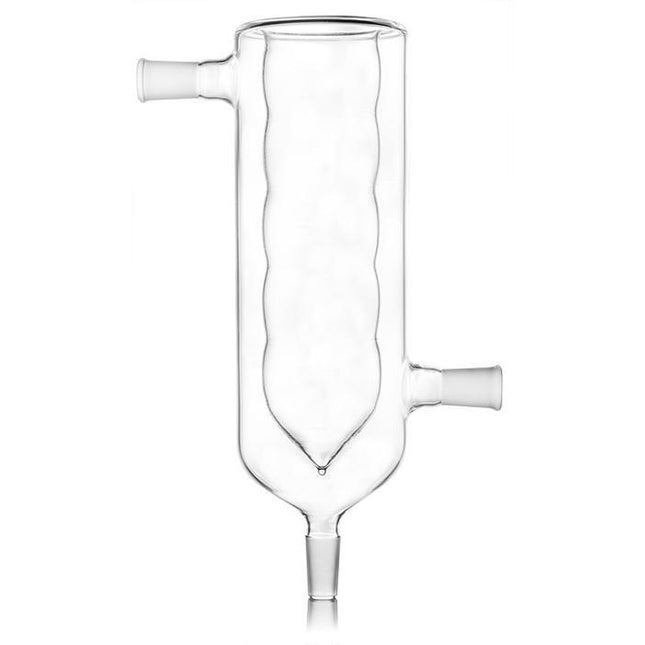
Glass Cold Trap - Ribbed (Made in USA)
BVV™ Glass Cold Trap - Ribbed This dewar style glass is designed to increase surface area for maximum vapor condensation and it also has 24/40 or 34/45 jointed connections to increase vapor flow. Note: The bottom joint will always be 24/40. *Notice to customers: All units are inspected for broken glassware or parts before leaving BVV™. If the unit arrives damaged (this does not include minor imperfections or scuffs in glassware), the customer MUST contact BVV™ within 72 hours from carrier delivery to file a claim. If the customer DOES NOT contact BVV™ within 72 hours from carrier delivery, then BVV™ cannot issue any replacement(s) or compensation for the item; a new purchase will need to be made for a replacement.
$700.24
-


Glass Dosing Syringe with Luer Lock
Glass Dosing Syringe with Luer Lock This high-quality glass syringe has metal triple O-ring plunger that allows for smoother dosing and Luer Lock Cap creates an airtight connection to preserve the freshness of concentrates and prevent leakage. The syringe is made from borosilicate glass, which is heat resistant, sturdy, and easy to clean! The silicone tip ensures you are sparing no oil and every last bit is dispensed.
$2.10 - $378.13
-
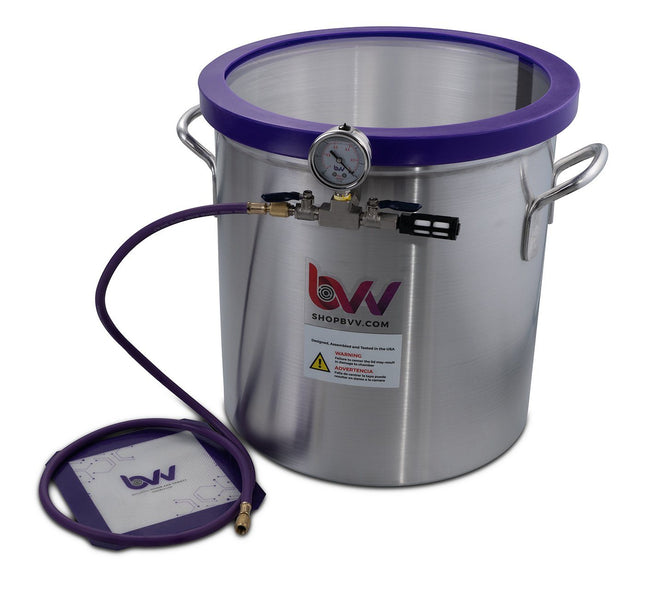
Glass Vac 10 Gallon Aluminum Vacuum Chamber
Glass Vac 10 Gallon Aluminum Vacuum & Degassing Chamber (Comes with 2 Year Limited warranty) This is a complete BestValueVac® vacuum chamber setup designed built and 100% tested in Naperville, Illinois. With our unique patent pending gasket design (Utility Patent #9475627) this chamber is sure to last 10,000 uses with proper care and maintenance. The gasket itself is reversible (doubling the life of our system) allowing customers to instantly take it off and flip it over. Every chamber is tested prior to shipping to lose no more than 2.5Hg/24hrs. Glass Vac Vacuum Chambers are ideal for wood workers using the wood stabilization process because the glass lid will not deteriorate like acrylic or polycarbonate lids. -Please Refer to these charts for vacuum specifications at altitude and conversions: Vacuum at Altitude Chart Vacuum Conversion Chart Key Features: Aluminum Vessel Chemically Inert Glass Lid Highly Durable and Reversible Silicone Gasket Glycerin filled vacuum gauge User friendly vacuum connections that fit most vacuum pumps on the market 50 Micron Air filter for reducing airborne contaminants when releasing the vacuum Silicone vacuum pad 5' of vacuum rated HVAC hose to pull a vacuum. Specification Chamber Material 3004 Aluminum Gasket Material Silicone Lid Material Glass Internal Dimensions (ID) 15" Tall x 14" Diameter Vacuum Gauge (Glycerin Filled) InHG (0)-(-30) Manifold Connections 1/4" SAE and 1/4" FNPT Temperature Rating 150°F (65°C) Additional Included Items 5' Purple Vacuum Rated HVAC HosePlatinum Cured Silicone PadBlack 50 Micro Air Filter Compatibility Explanation: BestValueVac® Chambers are not compatible with stabilization resin (i.e. Cactus Juice™, Gator Venom™, Minwax™ etc.), alcohol, ethanol, acetone and acrylic based monomers or polymers.The lid may only be cleaned with soapy water. GlassVac® chambers are compatible with all solvents and stabilization resins. We only recommend and warranty GlassVac® chambers for resin infusion and wood stabilization.The lid may be cleaned with any solvent or cleaning agent. See FAQ at the top for product safety warnings. Pump Warranty Information: Customers using solvents such as stabilization resins (MinWax™, Gator Venom™ etc.), alcohol and other polar solvents must use the vacuum pumps in conjunction with a cold trap for evacuations in excess of 5 minutes. (Exludes Cactus Juice™) If the consumer is using the pump for prolonged periods of time exceeding 5 minutes we require that a cold trap is used or the pump warranty is void. These stabilization resins have the ability to break down the internal components of the pump that are plastic resulting in a seized motor voiding all warranties. When evacuation exceeds 5 minutes these solvents begin to vaporize and then re-condense in the vacuum pump reservoir. Once enough solvent re-condenses in the pump displacing the oil the plastic internal components may begin to warp, melt or seize. The use of a cold trap will condense the vapors prior to making their way to the vacuum pump preventing pump damage due to excessive use. Furthermore, Minwax Wood Hardener™ is not to be used with any vacuum pumps, EVER. (A seized motor will result within the first use.) To prevent these issues from happening to your process, change the Oil after each vacuum pump use, Even if the use time is only 5min. For shipping info including Import/Export details visit our Shipping link at the bottom of the page.
$460.76
-
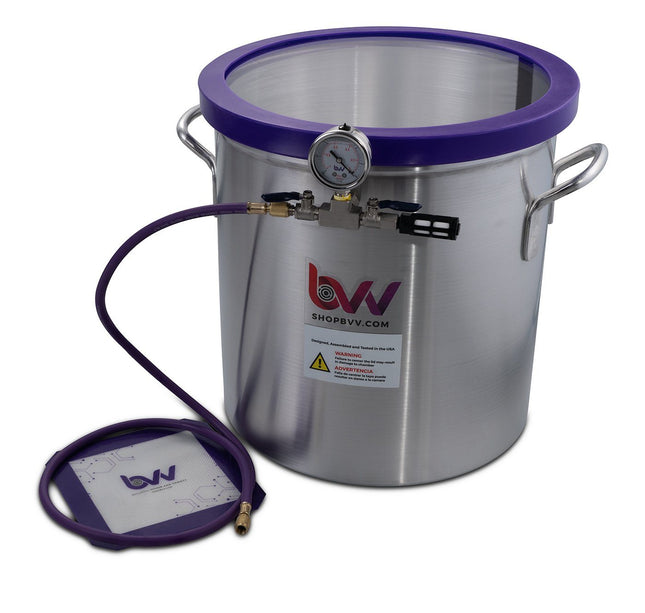
Glass Vac 15 Gallon Aluminum Vacuum Chamber
Glass Vac 15 Gallon Aluminum Vacuum Chamber (Comes with 2 Year Limited warranty) This is a complete BestValueVac® vacuum chamber setup designed built and 100% tested in Naperville, Illinois. With our unique patent pending gasket design (Utility Patent #9475627) this chamber is sure to last 10,000 uses with proper care and maintenance. The gasket itself is reversible (doubling the life of our system) allowing customers to instantly take it off and flip it over. Every chamber is tested prior to shipping to lose no more than 2.5Hg/24hrs. Glass Vac Vacuum Chambers are ideal for wood workers using the wood stabilization process because the glass lid will not deteriorate like acrylic or polycarbonate lids. -Please Refer to these charts for vacuum specifications at altitude and conversions: Vacuum at Altitude Chart Vacuum Conversion Chart Key Features: Aluminum Vessel Chemically Inert Glass Lid Highly Durable and Reversible Silicone Gasket Glycerin filled vacuum gauge User friendly vacuum connections that fit most vacuum pumps on the market 50 Micron Air filter for reducing airborne contaminants when releasing the vacuum Silicone vacuum pad 5' of vacuum rated HVAC hose to pull a vacuum. Specification Chamber Material 3004 Aluminum Gasket Material Silicone Lid Material Glass Internal Dimensions (ID) 17.2" Tall x 16-1/8" Diameter Vacuum Gauge (Glycerin Filled) InHG (0)-(-30) Manifold Connections 1/4" SAE and 1/4" FNPT Temperature Rating 150°F (65°C) Additional Included Items 5' Purple Vacuum Rated HVAC Hose Platinum Cured Silicone Pad Black 50 Micro Air Filter Compatibility Explanation: BestValueVac® Chambers are not compatible with stabilization resin (i.e. Cactus Juice™, Gator Venom™, Minwax™ etc.), alcohol, ethanol, acetone and acrylic based monomers or polymers.The lid may only be cleaned with soapy water. ShatterVac® chambers are not compatible with stabilization resin (i.e. Cactus Juice™, Gator Venom™, Minwax™ etc.), acetone, acrylic based monomers or polymers. The lid may be cleaned with soapy water and low strength cleaning agents. GlassVac® chambers are compatible with all solvents and stabilization resins. We only recommend and warranty GlassVac® chambers for resin infusion and wood stabilization.The lid may be cleaned with any solvent or cleaning agent. See FAQ at the top for product safety warnings. Pump Warranty Information: Customers using solvents such as stabilization resins (MinWax™, Gator Venom™ etc.), alcohol and other polar solvents must use the vacuum pumps in conjunction with a cold trap for evacuations in excess of 5 minutes. (Exludes Cactus Juice™) If the consumer is using the pump for prolonged periods of time exceeding 5 minutes we require that a cold trap is used or the pump warranty is void. These stabilization resins have the ability to break down the internal components of the pump that are plastic resulting in a seized motor voiding all warranties. When evacuation exceeds 5 minutes these solvents begin to vaporize and then re-condense in the vacuum pump reservoir. Once enough solvent re-condenses in the pump displacing the oil the plastic internal components may begin to warp, melt or seize. The use of a cold trap will condense the vapors prior to making their way to the vacuum pump preventing pump damage due to excessive use. Furthermore, Minwax Wood Hardener™ is not to be used with any vacuum pumps, EVER. (A seized motor will result within the first use.) To prevent these issues from happening to your process, change the Oil after each vacuum pump use, Even if the use time is only 5min. For shipping info including Import/Export details visit our Shipping link at the bottom of the page.
$585.40
-


Glass Vac 15.25" Diameter LID
Glass Vac 15.25" Diameter LID Disclaimer: This item Includes Lid and Gasket Only This is a Replacement Lid for the following Vacuum Chambers: Glass Vac 10 Gallon Aluminum Vacuum Chamber
$266.09
You have seen 624 out of 1081 products



































































